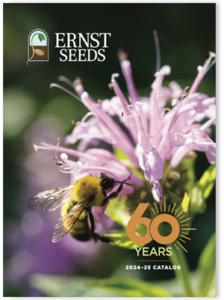Invasive species like Canada Thistle and Bull Thistle can wreak havoc on local ecosystems in the northeastern United States. Left unchecked, they can dominate other beneficial flora, negatively impacting biodiversity and agriculture.
Understanding how these species take hold is the first step in controlling them.
In today’s guide, we’ll explain what you need to know about these invasive species and their impact and provide you with some proven strategies to eliminate them before they become a nuisance.
Overview of Thistle Plants as Invasive Species
There are two major invasive species of thistle we want you to know how to control:
Canada Thistle (Cirsium arvense):
In the northeast, when meadows fail due to weed invasion, Canada Thistle is one of the most common culprits (along with Mugwort).
Despite its name, Canada Thistle was originally native to Europe and Asia. It was inadvertently introduced to North America in the early 1600s via contaminated crop seed. It’s a perennial herbaceous plant with spiny lobed leaves, creeping roots, and purple flowers. If not controlled prior to meadow establishment, the plant will quickly establish from the roots.
Canada Thistle forms dense monocultures that outcompete native vegetation. It’s particularly prevalent in disturbed areas such as roadsides, pastures, and agricultural fields.
Of particular concern is the fact that its seeds can persist for over 20 years in the soil. This means that if it has grown on your meadow site prior to planting, it will try to re-establish itself for years to come.
Bull Thistle (Cirsium vulgare):
Bull Thistle was originally native to Europe, northern Africa, and western Asia. It was introduced to the eastern U.S. in the 18th century and today is widespread throughout the country, particularly in the northeast.
The plant is biennial, with large purple flower heads, and can grow up to 2 meters. It reproduces solely by seed, and each plant produces thousands of them.
It’s commonly found in pastures, fields, and disturbed sites, where it easily outcompetes native plants for resources and deters wildlife grazing with its spiny leaves and stems. Like Canada Thistle, Bull Thistle seeds can persist for many years in the soil, posing a potential problem for over ten years.
Controlling thistles starts with identifying them. If your meadow has ever had thistle growing on it in the past, you’ll need to monitor the landscape for its recurrence for decades regularly.
Impact of Invasive Thistles on the Northeastern U.S. Ecosystem
Invasive species, like thistles, are considered invasive because they can outcompete native species that have evolved without strategies to defend themselves. When native plants are stifled, everything from agriculture to soil and water dynamics can be negatively impacted.
Biodiversity Loss
When thistles are present, native flora struggle to compete, leading to corruptive monocultures. This is not only a problem for flora but fauna as well, since reduced native vegetation means reduced habitat presence and quality for native fauna. Pollinators are particularly affected since their food sources can be quickly overwhelmed.
Agricultural Challenges
Thistles pose a real economic danger to farmers. They invade croplands and pastures, reducing forage quality and crop yields. Their presence increases management costs for farmers due to the need for control measures.
Soil and Water Dynamics
Thistle invasions can also cause long-term damage to the environment. Their dense stands can alter soil composition and hydrology, potentially affecting water availability and quality for years.
Avoiding the negative effects of thistles requires a combination of management and control strategies. However, there’s no short-term fix. Their seeds’ persistence means they can still pose a threat for years to come.

Management and Control Strategies for Thistle Plants
The best treatments for Bull and Canada Thistle are mechanical and chemical. Regardless of your method, you’ll need to keep a close eye on your landscape for decades to ensure they don’t re-establish themselves.
Mechanical Control
Mechanical methods refer to the physical removal of the plants.
- Mowing is effective for preventing either plant from seeding. However, Canada Thistle can still spread via rhizomatous growth, so we don’t recommend it for these invasions.
- Hand-pulling is feasible for small infestations of Bull Thistle. To prevent regrowth, you must remove as much root as possible.
Chemical Control
Chemical methods can be highly effective since they can kill the plant before it seeds and destroy the root system; however, you will need multiple treatments over multiple seasons to eradicate the plant.
- Herbicides: Selective herbicides can target thistles without harming native plants. Application timing is crucial for effectiveness. A spring treatment aims to eliminate the first flush of growth before seeding and again in the fall to maximize injury to the root system.
- Considerations: Even selective herbicides can inadvertently damage native flora, so choose one that won’t injure beneficial flora. Always read and follow the product label when using herbicides.
The key to controlling thistles is vigilance. It’s highly unlikely that you’ll destroy the plants with just a single treatment, whether chemical or mechanical. However, with several years of consistent treatment, you can successfully manage these invasive plants and keep your landscape healthy and diverse.
How Ernst Can Help with Native Plant Restoration after a Thistle Invasion
As we’ve stated multiple times in this guide, long-term monitoring is critical when you’re facing a thistle invasion. Becoming familiar with the look and behavior of these plants will give you the tools you need to keep them at bay.
Choose seeds and management practices that maximize your chance of success, but don’t forget that one battle won’t win the war. You’ll need to combine control methods with a smart plan for native plant restoration and regular assessment of restoration sites to detect and manage any resurgence of invasive species.
Seed Selection and Sourcing–Ernst has You Covered
The key to a successful meadow lies in your seeds. Utilizing locally adapted native seeds increases the success rate of your restoration efforts.
Native plants are the best option for keeping your meadow healthy, biodiverse, and stable. They can’t prevent invasive thistles from establishing, but they’ll occupy niches that support local fauna and enhance resiliency, which should be the goal of your meadow planning.
Ernst Conservation Seeds offers a variety of native species suitable for restoration projects in the northeastern U.S. Take a look at our inventory, or get in touch with us for advice on your specific situation.


